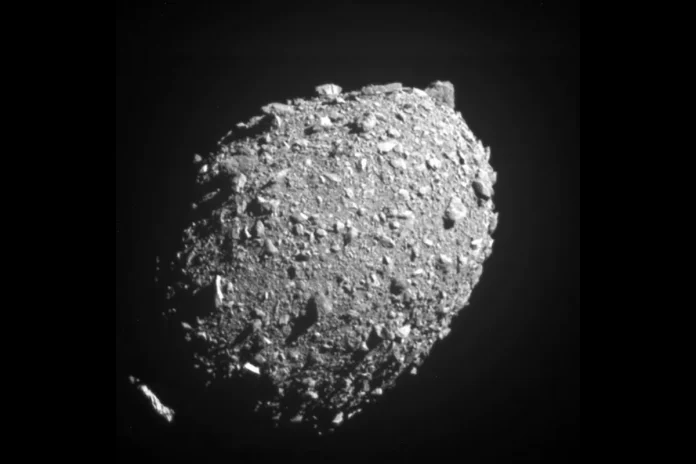In a world first, NASA has crashed a spacecraft into an asteroid in an attempt to push the rocky traveler off its trajectory. The Double Asteroid Redirection Test – or DART – is to test a possible approach that could prevent an asteroid from colliding with Earth. David Barnhart is a professor of space science at the University of Southern California and director of the Space Engineering Research Center there. He watched the live stream of NASA’s successful mission and explained what is known so far.
1. What do the pictures show?
The first images, taken by a camera aboard DART, show the double asteroid system of Didymos – about 2,500 feet (780 m) in diameter – being orbited by the small asteroid Dimorphos that is about 525 feet (160 m) tall.
As the targeting algorithm on DART kicked off on Dimorphos, the craft adjusted its flight and began moving toward the smaller of the two asteroids. The image, taken 11 seconds before impact and at a distance of 42 miles (68 kilometers) from Dimorphos, shows the asteroid centered in the camera’s field of view. This meant that the targeting algorithm was fairly accurate and the craft would collide in the center of the dimorphos.
The second-to-last image, taken two seconds before impact, shows the rocky surface of Dimorphos, including small shadows. These shadows are interesting because they suggest that the camera aboard the DART spacecraft was looking at Dimorphos directly but the Sun was at an angle relative to the camera. They mean that the DART spacecraft was focused on its trajectory to impact Dimorphos at this time, but it is also possible that the asteroid is moving too slowly relative to the camera.
The final photo, taken a second before impact, shows only the top fragment of an image but it is incredibly exciting. The fact that NASA received only part of the image means that the shutter took the picture but the dart traveling at about 14,000 mph (22,500 kph) was unable to transmit the entire image before impact. was.
2. What was to happen?
The purpose of the DART mission was to test whether it was possible to deflect an asteroid by kinetic impact—by crashing something into it. NASA used the analogy of a golf cart hitting the side of the Egyptian pyramids to express the relative difference in size between the smaller Dart and Dimorphos, the smaller of the two asteroids. Before the test, Dimorphos orbited Didymos in about 16 hours. NASA expects that to shorten Dimorphos’ orbit by about 1 percent, or about 10 minutes. Although small, if done far enough from Earth, such a nudge could potentially propel a future asteroid toward Earth long enough to prevent an impact.
3. What do we already know?
The last bits of data that came from the DART spacecraft just before impact suggest it certainly was. The fact that the images stopped communicating after reaching the target point could only mean that the impact was successful.
While a lot of information is likely to be learned from the images taken by the dart, the world will have to wait to know if the deflection was successful as well. Fifteen days before the impact, DART released a small satellite with a camera designed to document the entire impact. The small satellite’s sensors should have taken pictures and gathered information, but given that it doesn’t have a large antenna onboard, the images will be gradually transmitted back to Earth one by one over the coming weeks.
4. What is meant by testing for planetary defense?
I believe this test was a great proof-of-concept for many technologies that the US government has invested in over the years. And crucially, it proves that it is possible to send a craft to intercept with a small target millions of miles away from Earth. Dart has been a great success in this respect.
Over the course of the next months and years, researchers would learn how much deflection was caused by the impact – and most importantly, whether this type of kinetic impact would actually move a celestial object such a short distance away enough to prevent future asteroid strikes. can be taken away from threatening the earth.













